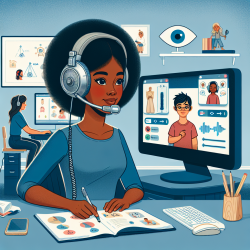In the ever-evolving landscape of speech therapy, the advent of telepractice has revolutionized the way Speech Language Pathologists (SLPs) deliver services. At TinyEYE, we are committed to supporting SLPs by providing robust online therapy services that ensure every child receives the care they need, no matter where they are. A key component of successful telepractice is the creation of effective tools tailored to the online environment. This blog will explore how SLPs can craft these tools to enhance their practice and outcomes for their students.
Understanding the Unique Needs of Online Therapy
Online therapy presents unique challenges and opportunities compared to traditional in-person sessions. It is essential for SLPs to understand these differences to create tools that are both effective and engaging. Key considerations include:
- Ensuring accessibility for students with diverse needs
- Incorporating interactive elements to maintain engagement
- Utilizing multimedia resources to enhance learning
- Maintaining data security and privacy
Essential Tools for Telepractice
When it comes to telepractice, having the right tools can make a significant difference in the quality of therapy provided. Here are some essential tools that SLPs can create and utilize:
- Interactive Worksheets: Digital worksheets that students can complete in real-time during sessions help keep them engaged and allow for immediate feedback.
- Video Resources: Short, targeted videos can illustrate speech techniques and exercises, providing visual and auditory examples for students.
- Games and Apps: Educational games and apps designed for speech therapy can make learning fun and interactive, which is particularly beneficial for younger students.
- Progress Tracking Tools: Digital tools that track student progress over time can help SLPs tailor their therapy plans and celebrate milestones with students and their families.
Creating Customized Tools
One of the advantages of online therapy is the ability to customize tools to meet the specific needs of each student. Here are some tips for creating customized tools:
- Assess Individual Needs: Start by assessing each student's unique needs and challenges. This will guide the creation of personalized tools that target specific areas of improvement.
- Incorporate Student Interests: Engaging students by incorporating their interests into therapy tools can increase motivation and participation.
- Utilize Feedback: Continuously gather feedback from students and parents to refine and improve the tools you create.
- Collaborate with Colleagues: Sharing ideas and resources with other SLPs can inspire new tools and techniques that you might not have considered.
Leveraging Technology for Effective Therapy
Technology is at the heart of telepractice, and leveraging it effectively can enhance the therapy experience. Here are some ways to make the most of technology in online therapy:
- Use High-Quality Platforms: Choose reliable and secure platforms that offer features like screen sharing, interactive whiteboards, and video conferencing.
- Explore Software Options: There are various software options available that can assist in creating and managing therapy tools. Explore these options to find what works best for your practice.
- Stay Updated: Technology is constantly evolving, so it's important to stay updated on the latest tools and trends in telepractice.
Conclusion
Creating effective tools for online therapy is crucial for the success of telepractice. By understanding the unique needs of online therapy, utilizing essential tools, customizing resources, and leveraging technology, SLPs can provide high-quality care to their students. At TinyEYE, we are dedicated to supporting SLPs in their mission to make a difference in the lives of children through innovative online therapy services.
We hope this blog has sparked your curiosity and provided you with valuable insights into creating tools for online therapy. If you have any questions or need further assistance, feel free to reach out to us at TinyEYE.










